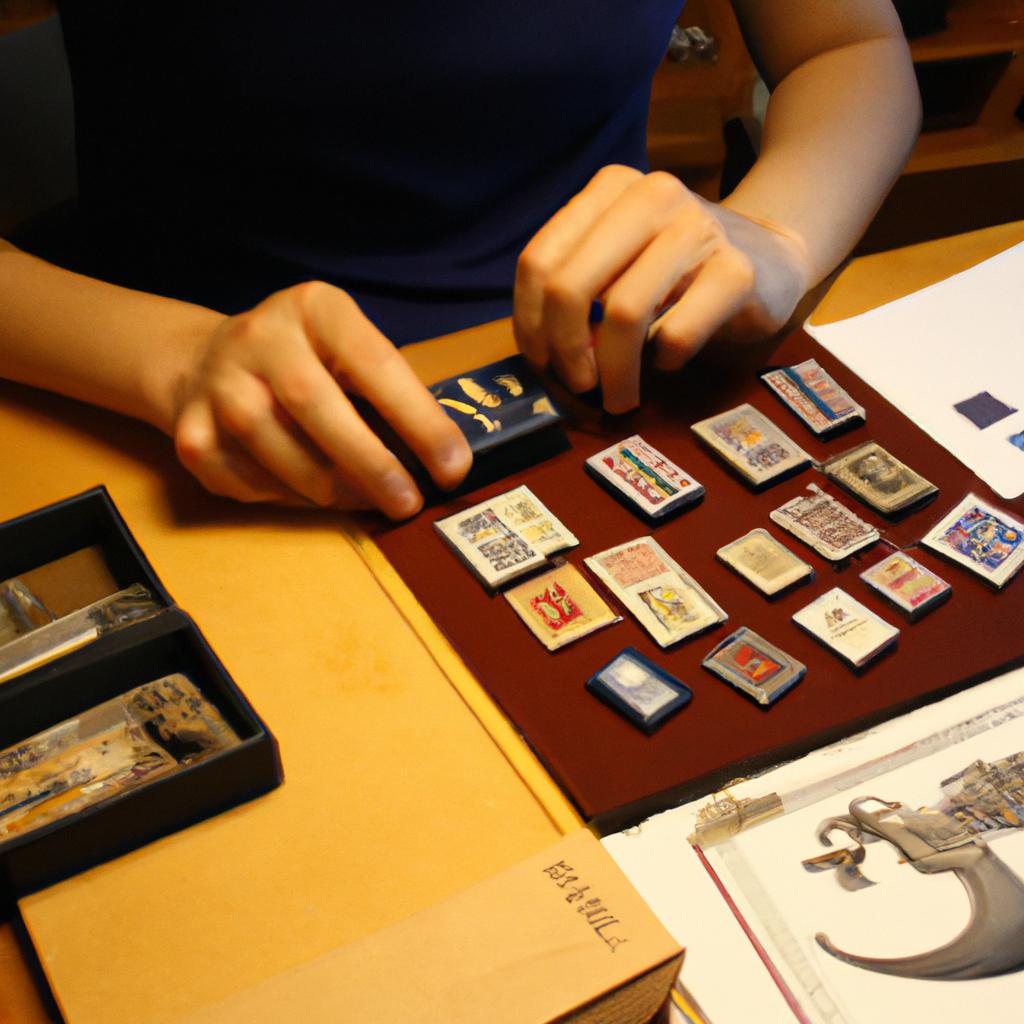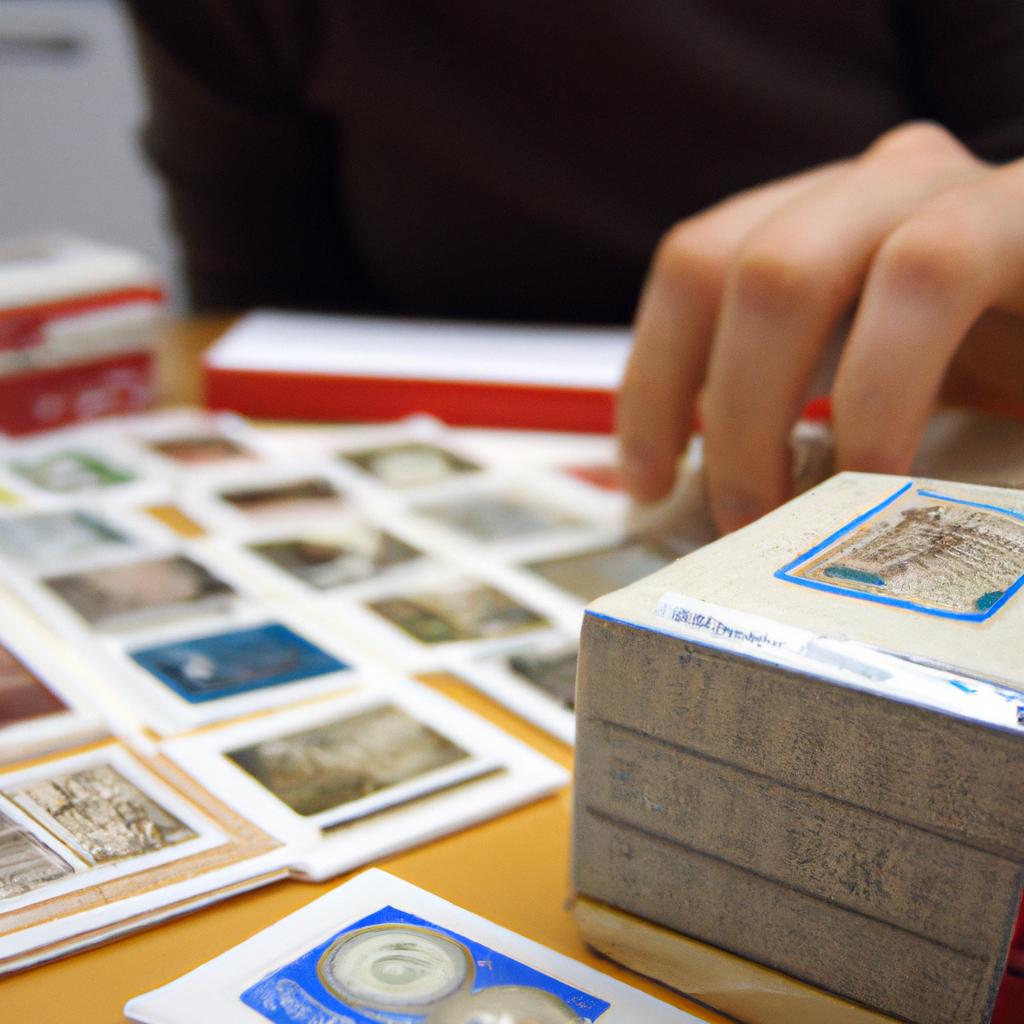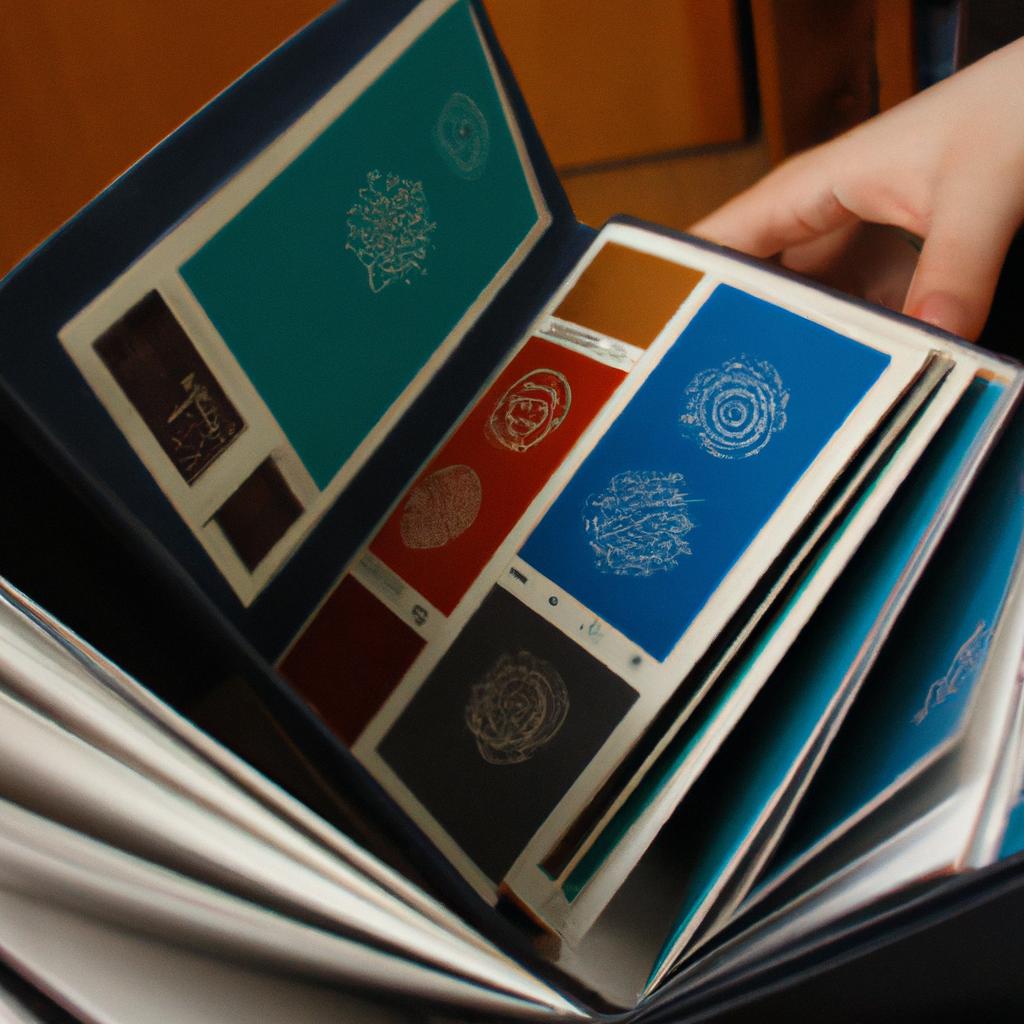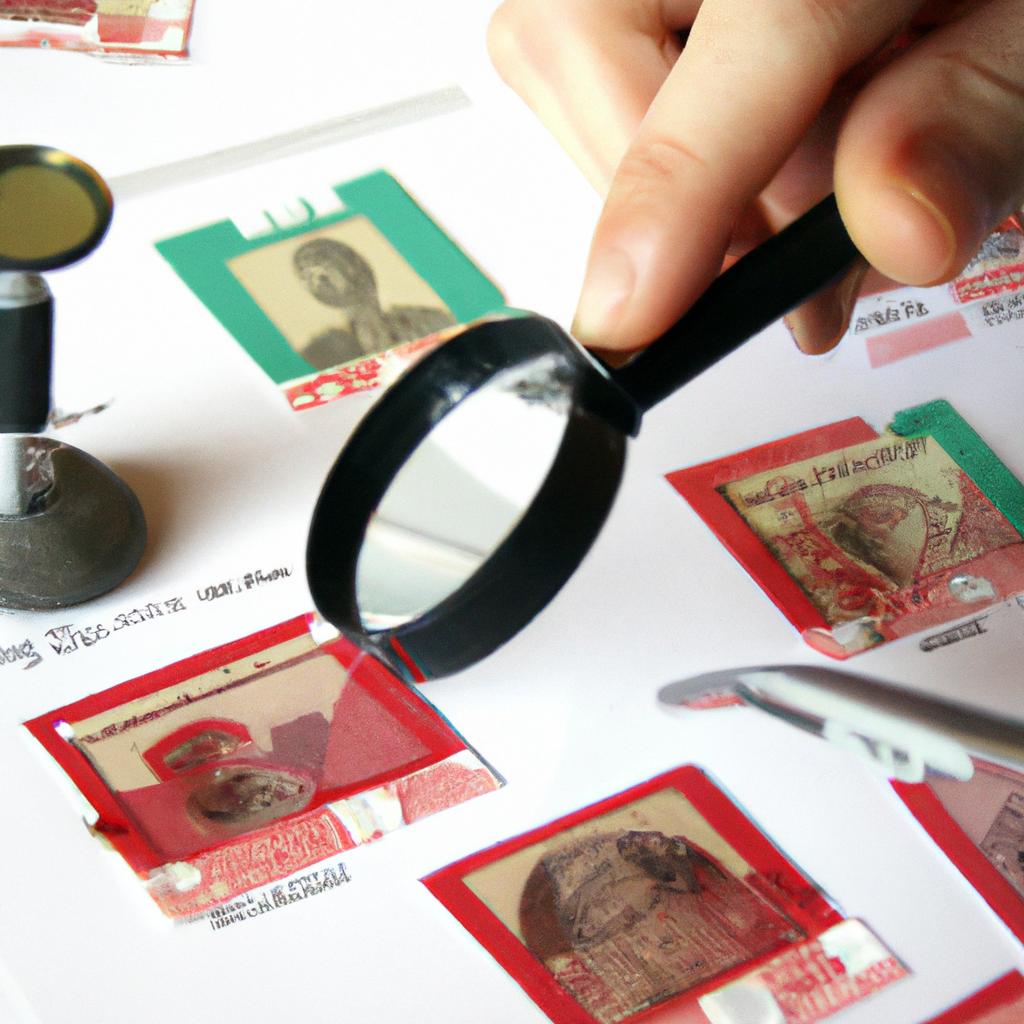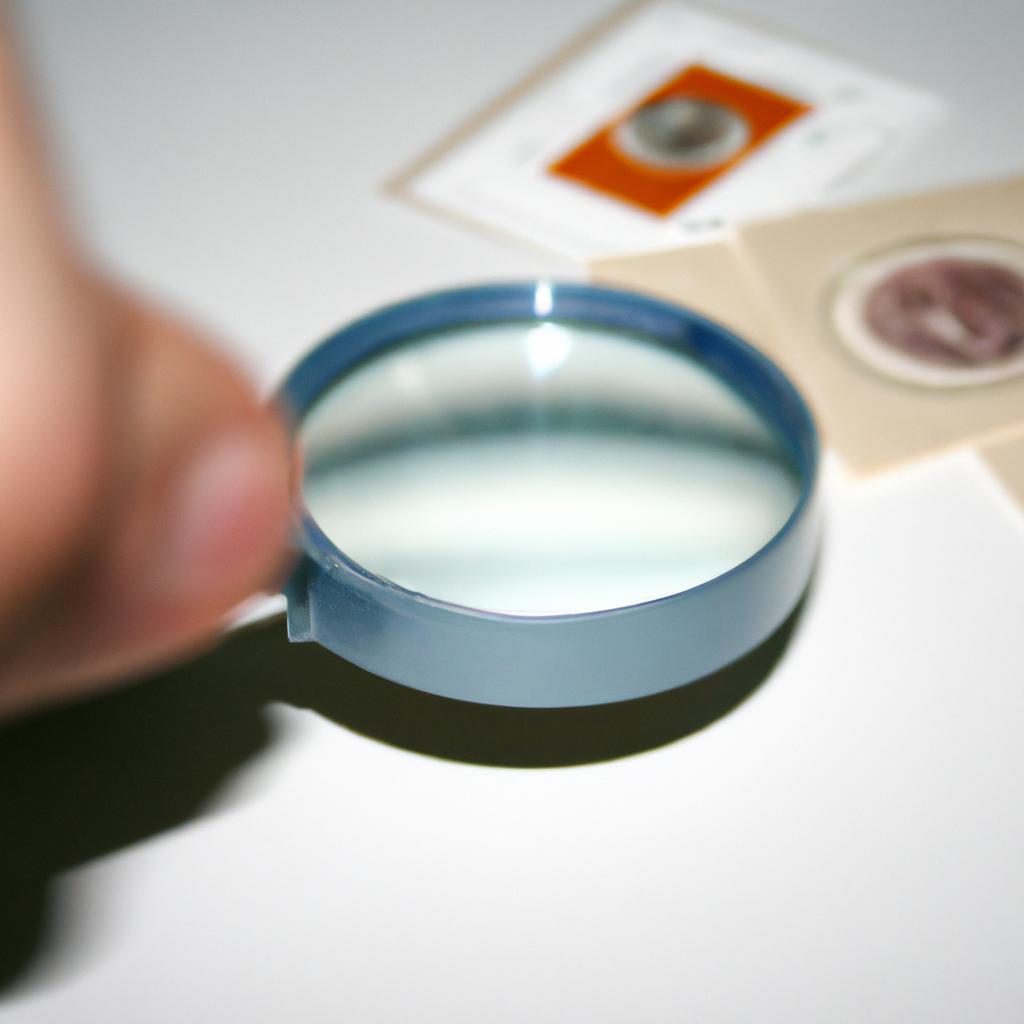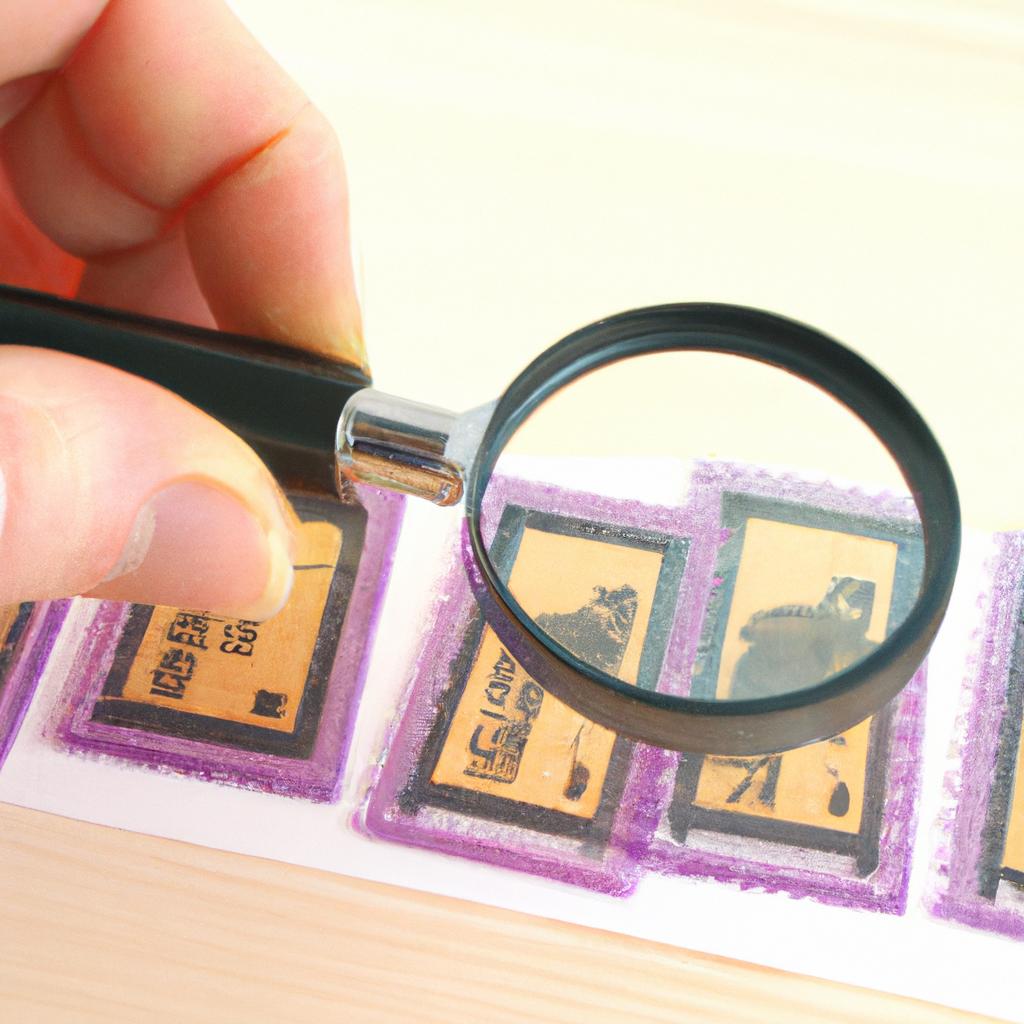Stamp Collecting Accessories: A Guide for Antiques and Collectibles Enthusiasts
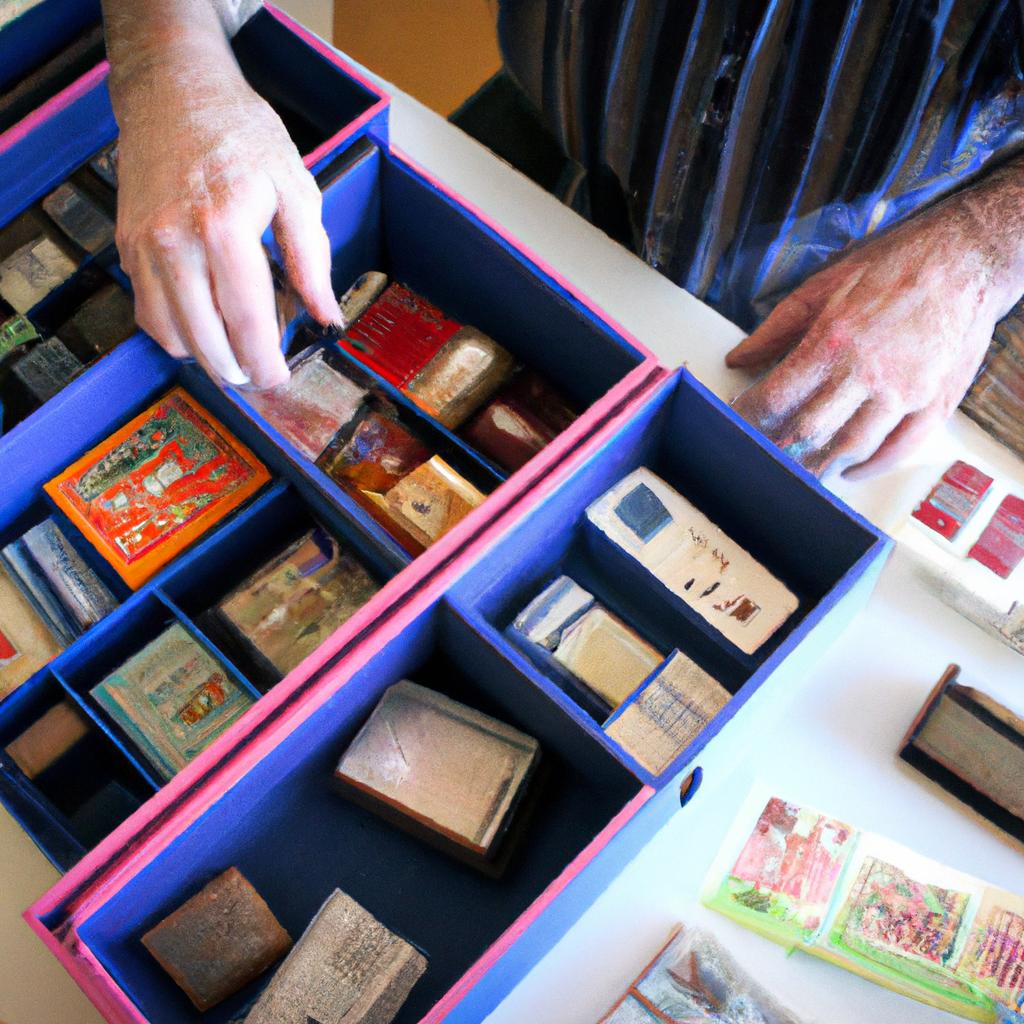
The world of stamp collecting is a fascinating and intricate one, filled with enthusiasts who appreciate the beauty and historical significance of these tiny pieces of art. For antiques and collectibles enthusiasts, stamp collecting accessories play a crucial role in preserving and showcasing their valuable collections. Whether it be specialized albums, magnifying glasses, or preservation tools, these accessories not only enhance the overall experience but also contribute to the long-term value of the stamps.
Imagine an avid collector stumbling upon a rare 19th-century postage stamp at an estate sale. The anticipation builds as he carefully examines the delicate piece under a high-powered magnifying glass, reveling in its minute details. He then meticulously places it into an acid-free archival sleeve for optimal protection against aging factors such as moisture and light. This scenario exemplifies how essential stamp collecting accessories are for collectors, enabling them to fully immerse themselves in their passion while safeguarding their cherished items from deterioration.
In this comprehensive guide, we will delve into the world of stamp collecting accessories, exploring their various types and functions. From album pages designed to organize stamps by country or theme to tongs used for handling delicate specimens without damaging them, we aim to provide antique and collectible enthusiasts with valuable insights on how to elevate their stamp collection and enhance their overall collecting experience.
One of the most fundamental stamp collecting accessories is the album. These albums come in various formats, including stockbooks, hingeless albums, and traditional stamp albums. Stockbooks are ideal for organizing stamps by country or theme, as they feature clear plastic pockets that allow collectors to easily view and arrange their collections. Hingeless albums, on the other hand, offer a more sophisticated option by providing pre-printed pages with mounts or pockets specifically designed for different stamp sizes and types. Traditional stamp albums often include blank pages where collectors can affix stamps using hinges or mounts.
To examine stamps up close and appreciate their intricate details, magnifying glasses are indispensable tools for collectors. Whether it’s a handheld magnifier or a desk lamp with built-in magnification capabilities, these instruments greatly aid in identifying subtle characteristics such as watermarks, perforations, and printing errors. With the ability to zoom in on specific areas of a stamp, collectors can better evaluate its condition and determine its value.
Preservation tools play a crucial role in maintaining the long-term value of stamps. Acid-free archival sleeves or mounts protect stamps from exposure to moisture, dust, and harmful UV rays that can cause fading or discoloration over time. Stamp tongs are specialized tweezers used to handle stamps without touching them directly. Made from materials such as stainless steel or nylon tips, these tongs prevent fingerprints and damage caused by natural oils present on our skin.
In addition to these essential accessories, there is a wide range of supplementary tools available to cater to collectors’ specific needs and preferences. Stamp watermark detectors help identify hidden watermarks by applying gentle pressure on the stamp surface while illuminating it from behind. Perforation gauges measure the number of perforations per 2 centimeters along the edges of a stamp, aiding in identification and classification purposes.
Ultimately, investing in high-quality stamp collecting accessories not only enhances the presentation and organization of a collection but also safeguards its value for future generations. These tools enable collectors to fully immerse themselves in the world of stamp collecting, appreciating the beauty and historical significance of these miniature works of art. So whether you are an experienced collector or just starting out, exploring the vast array of stamp collecting accessories can elevate your hobby to new heights.
History of Stamp Collecting Accessories
Stamp collecting, also known as philately, has been a popular hobby for enthusiasts all over the world. The history of stamp collecting accessories is fascinating and provides valuable insight into the evolution of this beloved pastime. To illustrate the significance of these accessories, let us consider the case study of John, an avid stamp collector who inherited a collection from his grandfather.
The first documented evidence of stamp collecting accessories dates back to the late 19th century when albums specifically designed for storing stamps became available in Europe. These early albums were made with high-quality paper and featured unique designs that appealed to collectors’ aesthetic sensibilities. Not only did they provide a practical means of organizing stamps, but they also added artistic value to the collections themselves.
To further understand the importance of stamp collecting accessories, we can explore their impact on collectors through an emotional lens:
- Preservation: By utilizing protective mounts or hinges, collectors can ensure that their precious stamps remain intact and unharmed by external factors such as moisture or light exposure.
- Display: Display frames allow collectors to showcase their prized stamps proudly while providing an opportunity for others to appreciate their beauty and historical significance.
- Organization: Specialized tools like perforation gauges help collectors measure the size and spacing between stamp perforations accurately, enabling precise identification and classification.
- Research: Philatelic literature serves as a valuable resource for collectors seeking information about rare stamps, historical contexts, printing techniques, and other relevant knowledge.
Table: Examples of Common Stamp Collecting Accessories
| Accessory | Description | Purpose |
|---|---|---|
| Stamp Tongs | Specially crafted tweezers made from non-reactive materials such as stainless steel or plastic | Allows delicate handling without damaging or contaminating the stamps |
| Magnifying Glass | A tool used to closely examine minute details of stamps, including watermarks and design intricacies | Enhances the viewing experience for collectors, enabling them to appreciate the finer elements |
| Perforation Gauge | A measuring device used to determine the perforations’ size and spacing on a stamp | Helps collectors identify specific varieties of stamps based on their unique perforation measurements |
| Stamp Catalogue | Comprehensive reference books that provide information about various types of stamps | Assists collectors in identifying, cataloging, and valuing their collections |
In conclusion, the evolution of stamp collecting accessories has greatly contributed to enhancing the overall philatelic experience. These tools not only serve practical purposes but also evoke emotional connections by preserving cherished memories and displaying artistic beauty. In the subsequent section, we will explore essential tools that every stamp collector should consider acquiring as they embark on this captivating journey.
Next Section: Essential Tools for Stamp Collectors
Essential Tools for Stamp Collectors
Transitioning from the previous section on the history of stamp collecting accessories, we now turn our attention to the essential tools that every stamp collector should have. To illustrate the importance of these tools, let us consider a hypothetical scenario:
Imagine you stumble upon an old box in your attic containing a collection of rare stamps inherited from your great-grandfather. Excitement fills your heart as you begin to examine each stamp’s unique design and intricate details. However, without the necessary tools and accessories at hand, preserving their condition and value becomes challenging.
To ensure that your prized stamp collection remains intact and well-maintained, here are some essential tools no serious collector should be without:
- Stamp Tongs: These specialized tweezers allow for delicate handling of stamps while minimizing damage caused by oils or moisture present on fingers.
- Magnifying Glass: A magnifier is indispensable when examining fine details, watermarks, perforations, and other characteristics that help identify and appreciate stamps’ uniqueness.
- Watermark Detector: This tool aids in identifying hidden watermarks within paper fibers – an important aspect when assessing authenticity and determining rarity.
- Perforation Gauge: Measuring perforations helps categorize stamps accurately according to their respective issues and varieties.
Now let us delve into a table displaying additional useful accessories for collectors:
| Accessory | Purpose | Importance |
|---|---|---|
| Stamp Mounts | Safely display individual stamps | Protects against damage |
| UV Lamp | Detect fluorescent properties in phosphorescent ink | Identifies certain types of ink |
| Stamp Drying Book | Facilitates safe drying after soaking | Prevents wrinkling |
| Stock Pages | Organizes stamps within albums | Provides easy access |
With these tools and accessories at hand, you can enhance both the enjoyment of delving into your stamp collection and the preservation of its historical and monetary value. Armed with this knowledge, we can now explore various types of stamp albums and stockbooks in the following section.
Transitioning into the subsequent section on “Types of Stamp Albums and Stockbooks,” it is important to note that selecting an appropriate album or stockbook plays a vital role in organizing your stamps’ display and ensuring their long-term protection.
Types of Stamp Albums and Stockbooks
Stamp Collecting Accessories: A Guide for Antiques and Collectibles Enthusiasts
In the previous section, we explored the essential tools that every stamp collector should have in their arsenal. Now, let us delve into the different types of stamp albums and stockbooks available to collectors.
When it comes to organizing and displaying your precious collection, choosing the right stamp album or stockbook is crucial. For instance, imagine you have a diverse collection of stamps from around the world – from classic British issues to rare Chinese commemoratives. In this case, a specialized worldwide album with pre-printed illustrations and spaces for each country would be ideal. Such an album not only provides structure but also enhances the aesthetic appeal of your collection.
Types of Stamp Albums:
-
Worldwide Album:
- Ideal for collectors with a wide range of stamps from various countries.
- Pre-printed pages offer organization based on countries or regions.
- Provides spaces for specific issues, allowing collectors to easily locate and display their stamps.
-
Thematic Album:
- Perfect for those who focus on collecting stamps related to specific themes such as animals, sports, or historical events.
- Pages are designed with thematic backgrounds and layouts to enhance the visual presentation.
- Allows collectors to create cohesive displays centered around their chosen theme.
-
Stockbook:
- Suitable for collectors who prefer a more flexible approach to organizing their stamps.
- Contains rows of clear pockets where stamps can be inserted individually.
- Offers easy access and allows rearrangement without damaging delicate items like gummed postage labels.
Now equipped with knowledge about different stamp albums and stockbooks, you can choose one that best suits your collection’s needs. By understanding these techniques, you will be able to maintain the integrity of your stamps and ensure their longevity in your collection.
[Transition into subsequent section about “Mounts and Hinges: Proper Ways to Attach Stamps”] As we continue our exploration of stamp collecting accessories, it is essential to understand how to securely attach stamps without causing damage.
Mounts and Hinges: Proper Ways to Attach Stamps
Having explored the various types of stamp albums and stockbooks, it is now essential to understand how to properly attach stamps within these collecting tools. By using appropriate mounts and hinges, collectors can ensure the preservation and presentation of their valuable stamp collections. Let us delve into the world of mounting techniques in this next section.
Mounts provide a protective enclosure for individual stamps while allowing them to be easily viewed without direct handling. These transparent sleeves are available in different sizes, catering to various stamp dimensions. For instance, imagine you have acquired an exquisite collection of rare British colonial stamps ranging from small definitives to large commemoratives. To accommodate such diverse sizes effectively, utilizing a range of mount sizes would be ideal.
When attaching stamps to album pages or stockbook leaves using hinges, it is crucial to follow proper procedures. Hinges consist of gummed paper strips that adhere one end to the backside of a stamp and the other end onto an album page or stockbook leaf. This method allows for easy removal without causing damage, unlike adhesives which may permanently bond the stamp with its display surface. Additionally, when applying hinges, ensuring they align correctly with designated spaces on album pages enhances aesthetic appeal and organization.
- Protect your cherished stamps from dust, moisture, and accidental damage.
- Safeguard against potential fading caused by prolonged exposure to light.
- Preserve historical value inherent in vintage postage artifacts.
- Showcase your collection’s beauty while maintaining its long-term condition.
The importance of implementing correct mounting techniques becomes even more evident when examining the table below, which highlights the potential consequences of improper stamp attachment methods:
| Improper Mounting Techniques | Consequences |
|---|---|
| Using non-archival adhesives | Risk of adhesive residue and damage to stamps upon removal. |
| Affixing stamps directly onto album pages/stockbook leaves without protective sleeves or hinges | Increased vulnerability to dust, moisture, and physical harm. |
As we’ve explored the proper ways to attach stamps using mounts and hinges, it is now time to delve into another crucial aspect of stamp collecting – magnifiers and lighting. By enhancing the viewing experience through these accessories, collectors can truly appreciate the intricate details of their rare postage treasures.
[Start next section H2: Magnifiers and Lighting: Enhancing the Viewing Experience]
Magnifiers and Lighting: Enhancing the Viewing Experience
Section H2: Magnifiers and Lighting: Enhancing the Viewing Experience
Now, let’s delve into another essential aspect of stamp collecting accessories – magnifiers and lighting. These tools play a crucial role in enhancing the viewing experience by allowing collectors to examine their stamps with precision.
To illustrate the significance of magnifiers and lighting, consider a hypothetical scenario where an avid collector discovers what seems to be a rare misprint on one of their stamps. Without appropriate magnification, it would be nearly impossible to identify such intricate details. However, with the aid of a high-quality magnifier that offers varying levels of zoom, collectors can closely inspect minute features like perforations or color variations.
When selecting a suitable magnifier for your stamp collection, keep in mind some key considerations:
- Magnification strength: Look for options that provide adjustable magnification levels, ranging from 5x to 20x, depending on your specific needs.
- Lens quality: Opt for lenses made from optical-grade glass or acrylic that offer distortion-free views.
- Ergonomics: Consider factors like weight, grip comfort, and ease of maneuverability when choosing a handheld or stand-mounted magnifier.
- Illumination options: Look for models equipped with built-in LED lights or compatible light sources to ensure optimal visibility while examining your stamps.
Now let’s turn our attention towards lighting solutions specifically designed for stamp collectors. Adequate illumination is vital as it helps reveal fine details otherwise obscured by shadows or poor contrast. Here are some suggestions to enhance your viewing experience:
| Light Source | Pros | Cons |
|---|---|---|
| Natural sunlight | Provides true colors; enhances overall clarity | Dependent on daylight availability; may cause fading over time |
| LED lamps | Energy-efficient; minimal heat emission; adjustable brightness | Initial investment; potential color temperature variations |
| UV lamps | Ideal for examining phosphorescent or fluorescent properties | Potential damage to stamps if used improperly; limited use scenarios |
By carefully considering these factors, you can select the most suitable magnifier and lighting options that align with your specific stamp collecting needs. The combination of an excellent magnifying tool and proper illumination will undoubtedly elevate your viewing experience and enable you to appreciate the intricate details within your collection.
As we conclude our discussion on magnifiers and lighting, it is essential to recognize their role in enhancing not only the aesthetic appeal but also the historical significance of stamp collecting. With each detailed examination made possible by these accessories, collectors gain a deeper appreciation for the craftsmanship involved in producing these miniature works of art.
Next, let’s explore another crucial aspect of stamp collection management – preservation and storage. Discover effective ways to protect your valuable stamps from external elements that could potentially deteriorate their quality over time
Preservation and Storage: Protecting Your Stamp Collection
Enhancing the viewing experience with magnifiers and lighting can greatly enhance a stamp collector’s enjoyment, but it is equally important to consider preservation and storage methods to protect your valuable stamp collection. Utilizing proper techniques will help safeguard against damage caused by environmental factors, mishandling, or accidents.
Consider the case of Mr. Johnson, an avid stamp collector who recently acquired a rare set of vintage stamps from his favorite era. He was thrilled with his new addition until he noticed that some of the stamps had faded due to prolonged exposure to sunlight. This unfortunate incident could have been avoided if he had known about effective preservation and storage practices.
To ensure long-term protection for your stamp collection, here are some essential guidelines:
- Acid-free materials: Use acid-free paper, envelopes, and albums to prevent discoloration or deterioration caused by acidic substances over time.
- Temperature control: Maintain a stable temperature range between 65°F (18°C) and 72°F (22°C) in your stamp storage area to avoid fluctuations that may result in damage.
- Humidity regulation: Aim for a relative humidity level around 50% to prevent excessive moisture absorption or drying out of stamps.
- Avoid direct light exposure: Store your stamps away from direct sunlight or fluorescent lights as UV radiation can cause fading and disintegration.
Incorporating these measures into your stamp collecting routine can significantly extend the lifespan of your cherished items. Additionally, you should also be mindful of potential hazards while handling stamps or organizing them within albums.
Table: Common Hazards When Handling Stamps
| Hazard | Impact | Prevention |
|---|---|---|
| Oily fingers | Stains and smudges | Use stamp tongs or gloves when handling |
| Rough surfaces | Scratches and tears | Work on a clean, smooth surface |
| Moisture | Water damage | Keep liquids away from stamps |
| Dust particles | Accumulation and deterioration | Clean stamps gently with soft brushes |
By following these guidelines and being aware of potential hazards, you can ensure the longevity of your stamp collection. Remember to regularly inspect your stamps for any signs of damage or decay, as early detection allows for timely intervention.
Preservation and storage play vital roles in maintaining the condition and value of your stamp collection. By proactively implementing proper techniques, you can safeguard your investment while enjoying the beauty and historical significance that each stamp represents.

